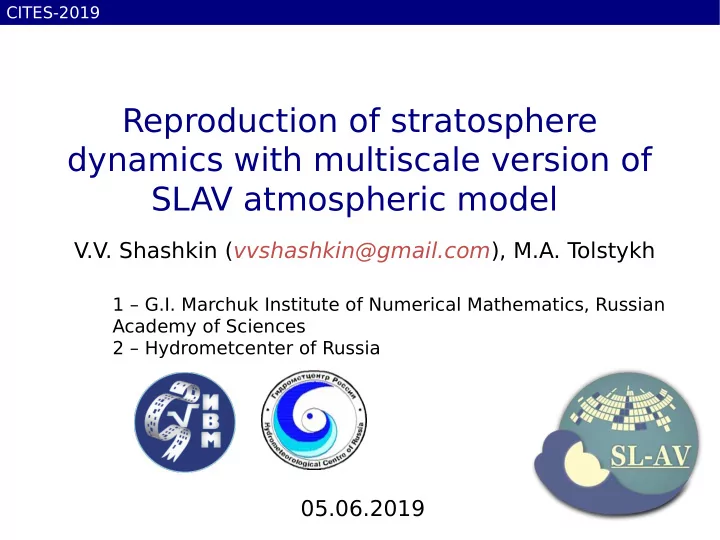

СITES-2019 Reproduction of stratosphere dynamics with multiscale version of SLAV atmospheric model V.V. Shashkin ( vvshashkin@gmail.com ), M.A. T olstykh 1 – G.I. Marchuk Institute of Numerical Mathematics, Russian Academy of Sciences 2 – Hydrometcenter of Russia 05.06.2019
Global SLAV atmospheric model (for seamless prediction) ● Own developed dynamical core (Tolstykh et al., GMD, 2017): - Semi-implicit semi-Lagrangian formulation Efficient - Vorticity-divergence representation of hor. velocity computations - Hybrid vertical coordinate p=Ap 0 +Bp s ● Subgrid scale processes parameterizations ALADIN / ALARO / LACE + RRTMG LW radiation + INM RAS multilayer soil + marine strat.cumulus (Fadeev) + NOGWD (Hines, 1997) ● Basic numerical method for medium-range weather forecast in Hydrometcentre of Russia ● Used in probabilistic seasonal forecast system of HMCR ● Work on seamless prediction system on the base of SLAV (+INMIO ocean+CICE sea ice) for medium-range / subseasonal / seasonal / decadal forecast
Points relevant for stratosphere modeling Vertical grid: - 96 levels, uppermost level at 0,03 hPa - key point: grid spacing ~500 m in 10-100 hPa (QBO is very sensitive to the vertical resolution) - l ower-troposphere resolution ~ current operative medium-range grid (51 level) - resolution in middle troposphere intentionally coarsened Vertical resolution as function of height
Points relevant for stratosphere modeling Ozone: - ERA-Interim 3D 1980-2010 monthly averages climatology - or the same using IPCC recommended data (thx. to E.M. Volodin) Subgrid scale gravity wave drag: - orographic (Geleyn et al.) ← GTOPO30 orography - non-orographic (Hines, 1997), pseudo-seasonal gravity-wave intensity distribution Vertical discretization scheme: - fin.diff (2-nd order accurate) – old default - finite elements (“hat-functions”, 2-nd order,[*]) - finite elements (cubic B-splines, 4-th order,[*]) – (hopefully) new default *-Untch, Hortal, QJRMS, 2006
Points relevant for stratosphere modeling momentum deposition, drag force wave breaking, turbulence Gravity waves generation
Points relevant for stratosphere modeling momentum deposition, drag force wave breaking, turbulence momentum deposition drag force Gravity waves generation Deep convection
Points relevant for stratosphere modeling Non-orographic gravity wave drag (NOGWD) parameterization: - describes propagation & breaking (mean flow interaction) for short gravity waves; - primary source is believed to be deep convection (also, small-scale tropospheric jetstreams instability); - especially important for QBO in upper QBO-zone (10-30 hPa); - gravity waves are “launched” at some level (usually 500 hPa); - waves amplitude at launch level is prescribed; - Hines parameterization: continuous vertical GW spectrum, 8-12 horizontal directions, non-linear interactions between waves.
Points relevant for stratosphere modeling Prescribed NOGWD waves intensity distribution at source level: - currently is ‘purely’ tuning parameter in almost all models; - usually zonally symmetric; Some illustrations for launch GW distribution: (sigma = root mean square norm of GW wind perturbations) * specific constants for ECMWF model are not known seasonal variation
Stratospheric dynamics verification: AMIP-like experiment Setup: - Prescribed SST and sea ice concentration; - ERA-Interim based ozone climatology (no trend); - nearly 30 years of simulation (1979-2006); Major points: - Computational stability (not so easy to achieve without decreasing timestep, as CFL can be >5); - Main features of zonal-averaged temperature and velocity fields; - Seasonal variations; - Tropical oscillations (QBO, SAO); - Northern winter (SSWs, etc.)
Stratospheric dynamics verification: AMIP-like experiment SLAV ERA-Interim December-January 1979-2006 averaged zonal-averaged U
Stratospheric dynamics verification: AMIP-like experiment SLAV ERA-Interim December-January 1979-2006 averaged zonal-averaged T
Stratospheric dynamics verification: AMIP-like experiment SLAV ERA-Interim June-August 1979-2006 averaged zonal-averaged U
Stratospheric dynamics verification: AMIP-like experiment SLAV ERA-Interim June-August 1979-2006 averaged zonal-averaged T
Quasi-biennial oscillation SLAV QBO reproduces: ● Realistic period of ~28 months ● Wind amplitude assymetry [-25,+15] m/s Biases: ● 5 m/s positive shift, especially below 50 hPa ● SAO amplitude decreased
Average QBO period (1979-2006)
Northern Hemisphere winter stratospheric circulation features Some important facts: ● Polar-night jet onset and destruction dates (average and variability) are qualitatively close to observations ● Wind speed is smaller by ~10 m/s, polar cap temperature greater by ~5 K ● 7,5 SSWs / 10 years against 5,5 in ERA-Interim - unique situation, usually there are less SSWs in models than really observed:)
Northern Hemisphere winter stratospheric circulation features Overall outcome: SLAV model can reasonably well reproduce stratosphere General problem: Total drag (resolved and sub-grid scale waves) is to strong in Nort. Hemsph.-DJF, and not enough in South.Hemisph.- JJA
Stratosphere resolving seasonal configuration of SLAV model: results Impact of reduced OGWD and improved OGWD surface flux formula: New GWD surf flux Old GWD surf flux
Summary - Stratosphere resolving grid for new SLAV seasonal/decadal prediction configuration is constructed - SLAV model reproduces major stratospheric circulation phenomena on seasonal and decadal prediction timescales reasonably well
СITES-2019 Thank you for your attention! Special thanks to R. Fadeev, G. Goyman, E.M. Volodin, P.Vargin for kind advices
Recommend
More recommend